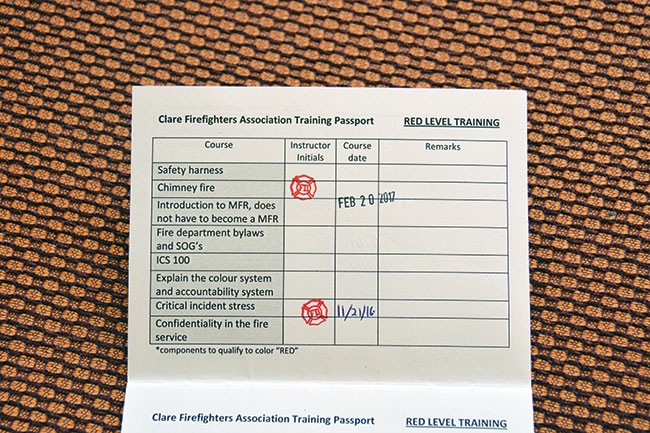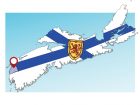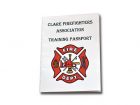
Features
Volunteers
Recruitment and retention: Firefighters association creates streamlined volunteer training program
Editor’s note: Bob Krause, a battalion chief in Toledo, Ohio, has become a bit of a Bluenoser, having taught workshops at FDIC Atlantic and instructing on weekends in various parts of the Maritimes. A longtime career firefighter and officer, Krause learned a little bit about himself in Clare, N.S., recently, about the Canadian volunteer fire service, its dedicated men and women and the professionalism they exhibit on the job and in their communities.
July 17, 2017
By Robert Krause
 The Clare Firefighters Association in Nova Scotia has developed a system to ensure its firefighters are trained to the level to which they want to participate in fire-ground activities. The program also includes an officer training component. The Clare Firefighters Association in Nova Scotia has developed a passport training program that allows volunteers to train for tasks within their comfort levels. Writer Bill Krause delves into how the program works in the latest issue of Fire Fighting in Canada.
The Clare Firefighters Association in Nova Scotia has developed a system to ensure its firefighters are trained to the level to which they want to participate in fire-ground activities. The program also includes an officer training component. The Clare Firefighters Association in Nova Scotia has developed a passport training program that allows volunteers to train for tasks within their comfort levels. Writer Bill Krause delves into how the program works in the latest issue of Fire Fighting in Canada.I had the privilege of training with members of the Clare Firefighters Association in Nova Scotia in April. The attendees to the conference came from many departments in the region; some traveled more than three hours to get to Clare. The weekend of training focused on fire fighting techniques, leadership development and firefighter safety. The attendees numbered almost 300.
Members of the planning committee for the training conference introduced me to a training system they developed called the Clare Firefighters Association Training Passport. The committee, developed the idea of a training passport after a number of incidents were identified that could have been run more smoothly. Modeled in appearance after a traditional travel passport, the training committee was guided by the National Fire Protection Association (NFPA) training standards.
The members of the committee worked for several hours and exchanged hundreds of emails to pull together a program of training to meet the needs of their region. They identified three levels of training that they felt would aid small volunteer departments attract and retain members, by allowing motivated individuals to participate in fire-ground activities based upon training they wanted to receive. With the safety and welfare of each individual volunteer at the forefront of the development process, three levels of training were established.
The red-level training focused on skills that would allow an individual to join the fire department and participate in activities outside the hot zone of a fire, such as first-aid, equipment stockpiling, rehab sector activities, and clean-up after a fire. The red-level significantly restricts members’ exposure to the dangers of structural fire fighting, while permitting them to be very supportive to interior crews.
The yellow-level training concentrates on more warm-zone activities; members are allowed to assist with exterior ventilation, establishing water supplies, scene lighting, forcible entry and exterior fire fighting. Those individuals who were interested in firefighting would be educated and trained on more than 17 topic areas, all according to NFPA guidelines. This expands the effective fire fighting force by including people who want to become a part of their local fire departments but may not wish to actively participate in interior fire suppression activities.
The highest level – green – includes all elements of both red and yellow-level training, but builds on those foundations by including a number of complex training components such as interior fire attack, breathing apparatus, search and rescue, and hazmat skills. As a member’s training levels expand, color designation tags on their helmets easily identify them to the incident commander and assists in assigning appropriate fire-ground tasks.
The passport training committee went so far as to develop and include officer training into the program. In addition to leadership, officer training includes basic cause-and-origin determination, fire-protection systems, public-education and ICS-200. No one can argue against officer training, since a highly-skilled officer is better able to resolve fire-ground problems.
I was struck by the committee’s desire to develop a training program that would encourage individuals to join their departments and provide a level of training commensurate with the desires of the new members, based upon how extensively they wanted to participate. Volunteer departments across North America are struggling to recruit and maintain volunteers. Training programs are often lacking and provide little excitement or incentive to remain a member of their community’s fire department. I strongly believe the Clare Firefighters Association has developed a solution to that problem.
What I found most impressive about the work of the Clare Firefighters Association is their laser focus on safety and training, and their work to include as many people as possible. There are individuals who do not wish to spend many hours training to be an interior firefighter but would jump at the opportunity to participate on the fire ground in water shuttle set-up, conduct rehab operations, or assist with the advancement of hoselines for the interior suppression crews. This training passport program may well just be the ticket to increase memberships.
Please don’t think that the Clare Association has or is willing to cut corners, or allow lesser-trained firefighters to do things for which they have not received documented training. Training records are maintained by the association and stamps are recorded within each member’s individual passport. Training records can be cross-checked to ensure a member has indeed received training, is proficient in a skill, and has been signed off by the instructor.
The true commitment to safety for firefighters and their families is also evident in this passport program. Any injury to a firefighter has wide-ranging effects. Families can suffer from an injury to their loved one, communities lose a responder, and employers lose a skilled worker. The use of this passport training program allows fire-department members to actively anticipate in a meaningful and supportive way on the fire ground. Officers can easily identify members’ training levels by the colour designation on their helmets, and assign them tasks in keeping with their skills. Not every member can be on the nozzle engaged in direct battle with the dragon inside a structure fire. Fire fighting is a team activity, always has been. This new training system and program of inclusion may very well be a real step forward in addressing the recruitment and retention of skilled volunteer firefighters in your community and across Canada.
Clare Firefighters Association member departments
- Havelock Area Volunteer
- Fire Department
- Hectanooga Fire Department
- Little Brook Volunteer Fire Department
- Meteghan Fire Department
- Salmon River and District
- Volunteer Fire Brigade
- Southville and Area Fire Department
- St. Bernard Fire Department
- Richfield Fire Department
I encourage anyone who may be interested in learning more about this passport training program to contact Daniel Gaudt of the Clare Firefighters Association at danielwg@eastlink.ca
Bob Krause is a battalion chief with the Toledo Fire Department in Ohio. Contact him at bobkrause@bex.net
Print this page
Advertisement
- Comment: Progress with Ottawa but challenges persist
- Well-being: Strategies to keep firefighters healthy


